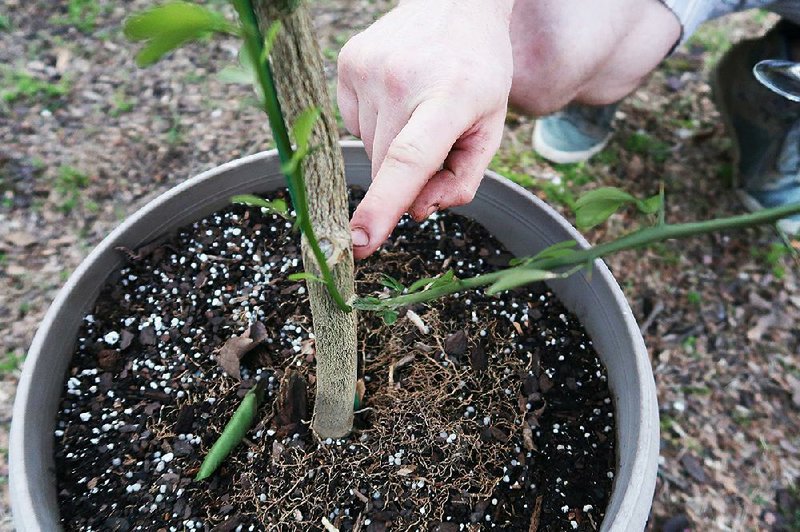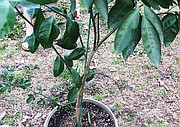MAY
It has been one of the prettiest springs on record here in Arkansas. Our gardens have gone from bloom to bloom, and it gets prettier every day.
Last year's milder summer coupled with an abundance of rain (sometimes too much) let our plants set a copious amount of blooms. Even though we did have cold days and some late frosts, we are not seeing much in the way of winter damage. April was good to our gardens so let's hope the trend continues in May and then the rest of the summer.
There is plenty to do in the garden, from harvesting to planting, so get out there and garden!
• Winter bedding plants are beginning to stretch and get leggy with the higher temperatures, so it is time to pull them and replant with summer color. Color makes a garden sing. Make sure you add some songs to your yard. From tropical blooming flowers to beautiful annuals and perennials, the problem may be narrowing down what you want to buy. Go visit your local nursery, garden center or Master Gardener plant sale, then start planting.
• Fertilization is needed to keep summer annuals blooming their best. Incorporate a slow-release fertilizer when planting, then follow up periodically with a granular or water-soluble type. How often to fertilize depends on what you are growing and how often you water (or we get rain).
• Some spring-blooming shrubs are still blooming while others are finishing up. If you have spring-blooming plants that need pruning, the sooner you prune after flowering, the faster they will recover. Some gardeners like to prune each bush as its blooms finish, while others like to wait until all the spring bloomers are done and prune them all at once.
• If you can, avoid the meatball, sheared look. A more natural appearance will be more pleasing, and it doesn't happen with electric shears. Selective thinning of branches is needed. Remember, if they are cane producing plants -- with multiple stems coming from the soil line, such as forsythia, spirea, flowering quince and mock orange, thin out older stems at the soil line.
• Knowing why you are pruning, when to prune and how will give you the most from your plants. Try to have all spring-blooming plants pruned by mid-June at the latest so they can recover before setting more flower buds in late summer/early fall.
• Lawns are greening up nicely, and winter weeds are beginning to die out. That doesn't mean they are gone for good, just taking a siesta for the summer. They will be back in the fall. It is too late to worry about killing them now, but summer weeds will begin to take their place. A thick, healthy lawn is the best offense. Once your lawn has fully greened up, fertilize with a slow-release, high-nitrogen fertilizer. One or two applications a year should suffice for most lawns.
• Vegetables are beginning to ripen from fall and early spring plantings. From lettuce and spinach to greens, English peas and broccoli and cabbage, there is plenty to eat from the garden.
• If you planted onions, it is too early for large onion bulbs, but you can harvest green onions at any size.
• Potatoes are growing well. When you see blooms, it will be time to harvest new potatoes. Some gardeners only grow them for these small, young tubers. Taking out your new potatoes allows a quicker harvest and frees up space in the garden, but they are tasty as well.
• It is time to start adding in all the warm-season plants. As you harvest one thing, plant another. There is still plenty of time to plant tomatoes, peppers, eggplants, squashes and more.
• If you have room or can trellis them, consider putting in watermelon, winter squash and even pumpkin vines. They are prolific, so give them plenty of room. Later this month you can also plant sweet potatoes and southern peas. I have small raised beds, so I buy fresh southern peas at the farmers market; but if you have room, they are easy to grow.
• As with any garden, monitor your vegetables for insects or diseases. The sooner you spot a problem, the sooner you can control it.
• Houseplants can be moved outside safely now. If you kept your hibiscus or mandevilla alive all winter indoors, repot now and cut them back by half. Fertilize and water, and they should bounce back. Tropical plants bloom on new growth. The plants get root-bound quickly, which doesn't allow for much new growth. Less growth, fewer flowers. Or you can do what I do and buy new plants each year.
BAGWORMS
There are three insects often called the same thing -- bagworms. This name can apply to eastern tent caterpillars, fall webworms and the real bagworm that produces a small teardrop-shaped bag and that attaches itself to junipers, cedars and the like.
The bagworm can be devastating to the plants it is feasting upon, but often the damage is not seen until too late, after the bags are constructed and the insects are finished eating. Bagworms begin constructing their small, individual bags mid-May through late June. If you have a plant that has been damaged in the past, preventive sprays once a week with Bacillus thuringiensis (Bt, DiPel) will get them before they get the plants.
Eastern tent caterpillars have made their appearance, and the first set of fall webworms won't be far behind.
Eastern tent caterpillars are short-lived but can be a nuisance while they are here. They normally construct a web in the fork of the tree. The insects congregate inside at night and on rainy days, but move out to feed during the day. Luckily, we just have one generation per year.
Fall webworms, however, can linger, with multiple generations per year. They tend to have favorite host plants each year, but while unsightly, usually do limited damage. Webworms tend to feed within their nest, and the nests or "webs" get larger and larger.
If the webs or tents are easily within reach, you can remove and destroy them. But don't risk life and limb by climbing up to get them, or risk damaging the trees in trying to burn them out. This all points to proper identification of the pest/disease-insect-weed, and then the proper treatment. When in doubt, call your local county extension office.
TERM OF THE MONTH
"Grafting" is a horticultural technique used to join parts from two or more plants so that they appear to grow as a single plant. In grafting, the upper part (scion) of one plant grows on the root system (rootstock) of another plant.
This is often done to trees and shrubs, to combine the best characteristics of the two plants. The most common plants that are grafted are fruit trees, roses and Japanese maples, but this technique is not limited to these plants.
The rootstock that is chosen is usually more vigorous and disease resistant. In the case of fruit trees, root stock is also chosen to limit mature size of the trees.
Today we are also seeing grafted tomato plants where heirloom or older varieties are grafted onto disease resistant cultivars. The results are more vigorous plants that have some disease resistance but more flavorful fruits.
Where the graft union has been made, there is a bumpy growth area. If you have any grafted plants and you see a sprout that grows from beneath the graft union, prune it out. Otherwise, the vigorous root stock will overtake the grafted top growth.
Read Janet Carson's blog at arkansasonline.com/planitjanet.
HomeStyle on 05/04/2019

